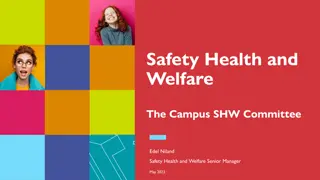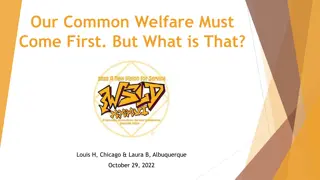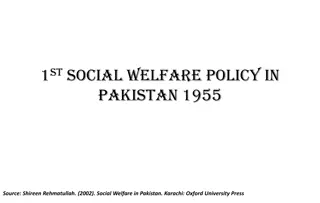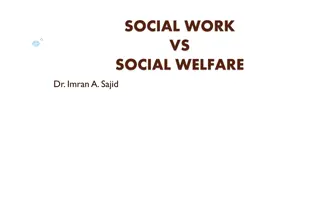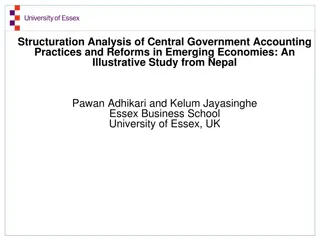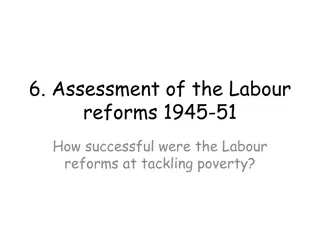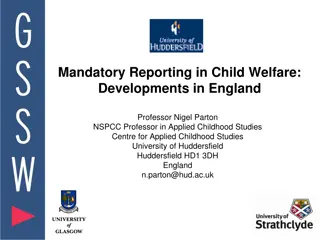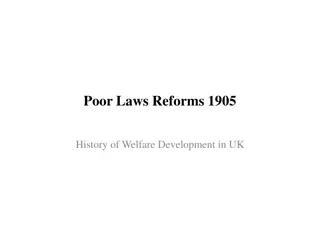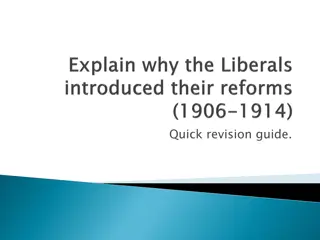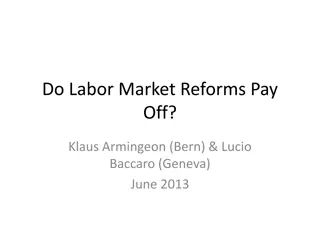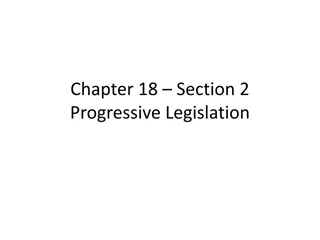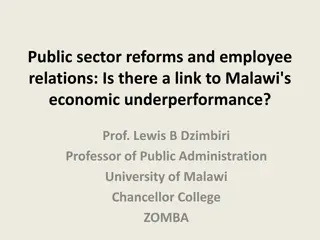Key Welfare Reforms and Future Developments
Introduction of Universal Credit, changes in family benefits, cuts in disability benefits, housing benefit changes, and more. Further updates include cuts, IT delays, and uncertainties in the roll-out of Universal Credit.
Download Presentation

Please find below an Image/Link to download the presentation.
The content on the website is provided AS IS for your information and personal use only. It may not be sold, licensed, or shared on other websites without obtaining consent from the author.If you encounter any issues during the download, it is possible that the publisher has removed the file from their server.
You are allowed to download the files provided on this website for personal or commercial use, subject to the condition that they are used lawfully. All files are the property of their respective owners.
The content on the website is provided AS IS for your information and personal use only. It may not be sold, licensed, or shared on other websites without obtaining consent from the author.
E N D
Presentation Transcript
Welfare Reform Update and future developments There for You Welfare Seminar Croyde 9thMay 2014
What are the key welfare reforms? Introduction of Universal Credit 6 benefits in 1 Family benefit changes Working Tax credits rules, Child benefit no longer universal 23 billion Disability benefits cuts and changes No annual uplifting of benefits 2013 - 2016 Housing benefits cuts LHA changes and payment caps Benefits Cap Bedroom Tax Social Care Bill - 72,000 Cap introduced Cap on the total benefits expenditure introduced
Further changes over the last year A further 12 billion of cuts to be permanently made The Bank of England s announcement that it would not raise interest rates if unemployment was above 7% The National Audit Office - highly critical report on the management of the introduction of Universal Credit ( 40 million written off 1 computer scheme; 425m in total but could be 700m) Roll out of Claimant Commitment and increase in the punitive Sanctions regime The government Help to Work a programme for long- term unemployed people including a workfare element The number of children in absolute poverty is expected to rise by 1.5 million by 2020
Universal Credit - Uncertainty of roll out and feasibility remains IT Delays: Simple cases - 0.2% of all benefit recipients will be on UC in 10 pathfinder/pilot areas until May 2014 3,200 people (compared to the 1.7 million timetabled) had been signed up to receive Universal Credit a fraction of the original target at a cost of nearly 200,000 per person - 612 million in total (Feb 2014) Now have 2 computer systems 1st for the pathfinders and 2ndone by Government Digital Services to be tested in November to see if its capable of delivering full scope of Universal Credit for all 12 million claimant types
Will the IT work? Culture of secrecy and lack of transparency Disjointed workings of HMRC, DWP, Employers, Local Government and UC clients Likely to end up partly face to face rather than fully online because of security issues RTI is likely to remain a total of separate systems but liabilities for mistakes, miscalculations are still to be clarified
Universal Credit - Uncertainty of roll out and feasibility remains June 2014 North West will expand the roll-out of Universal Credit to 12 more JCs 90 jobcentres, or 1 in 8 jobcentres in Britain, will offer the full Universal Credit once the north west expansion is completed Couples will begin to be included Just 1/10 families will benefit overall likely to remain with no political party opposition but with improved benefits calculations and IT
Women and families in welfare reforms Are Welfare Reforms helping women in the labour market, working families , family poverty and child poverty?
Women and employment trends TUC (September 2013) Over 1 million women been unemployed for two years Women's chances of being long-term unemployed have increased, the ratio of male long-term unemployment to female has been falling since before the recession 1.7 million under-employed women workers, 52% of all under- employed workers Underemployment rising 2 million employed in low-paid and insecure i.e. vulnerable employment. Women faced lower pay and were more likely to have experienced unfair treatment than men 56 per cent of zero hours workers are women Women = 1/3 of self-employed and 50% of the increase in self- employed since the recession The number of working age women classified as retired has been falling since the recession; this surprising result may be an effect of the raising of women's pension age
Gender jobs split in youth labour market (TUC November 2013) The proportion of young women trapped in low-paid, low-skill jobs has trebled over the last 20 years A rise number of females gaining qualifications but still find themselves trapped in low-skill, low-wage jobs Gender segregation is rife at the lower end of the youth jobs market. The proportion of young men doing personal service jobs had almost halved but 20% in skilled trades compared to 1% for females There is a big gender split in apprenticeships. Young women continue to dominate in traditional areas such as customer service, retail, health and social care: these female-dominated sectors typically offer fewer progression opportunities and lower pay Young women are getting a lower wage return on their qualifications. Despite being better qualified than young men, young women are seeing a lower wage premium for vocational qualifications.
Childcare costs year on year still rising Daycare Trust and Family and Parenting Institute Childcare Costs Survey 2013 Nursery and childminder places for over-twos rose by more than 5% over the last 12 months A parent in London buying 50 hours of childcare per week for a child under two would face an average annual bill of nearly 14,000 per year ( 11,000 average in UK)
Families and Child Poverty Joseph Rowntree Foundation (JRF) November 2013 According to JRF, among the 1.3 million families with children living in poverty 50% are working households: 31% (400,000 families) are couple families with a single breadwinner 16% (210,000 families) are dual earning couples; 8% (105,000 families) are working lone parents; The remaining families are either workless single parents or workless couples.
JRF make three recommendations 1. Allowing second-earners to keep more of their earnings 2. Expand the provision of affordable childcare universal childcare system 3. Make it easier for fathers to spend time with the family and share caring responsibilities
Disability welfare cuts and changes - Key elements 3.7 million people facing 28.3 billion cuts Abolition of Severe Disability Premium (SDP) and Independent Living Allowance (ILF) Reduced disabled child additions Abolition of the disability element of working tax credits Housing Benefit restrictions Bedroom Tax and Benefits cap
Disability welfare cuts and changes - Key elements Incapacity Benefits (IB) to become Employment Support Allowance (ESA) through the Workplace Capability Assessment (WCA) and then will become Universal Credit Abolition of DLA and replacement of Personal Independent Payment (PIP) Reduction of child care costs Pension Credit restrictions Carers and the carers premium in universal credit
Independent Living Fund (ILF) Court ruled in November 2013 that the government s decision to close the fund was unlawful Breach of the Equality Act s public sector equality duty as the former minister for disabled people did not have due regard to the impact on disabled people and the need to eliminate discrimination and advance equality of opportunity for disabled people
Closure of ILF June 2015 On 6 March 2014 the Minister for Disabled People, Mike Penning MP provided a written Ministerial statement on the future of the ILF. The government has taken the decision to close the ILF on 30 June 2015 and transfer responsibility for meeting the eligible care and support needs of current ILF users to local authorities in line with their statutory responsibilities. The ILF will therefore resume closure activity immediately, commencing with a new programme, similar to the transfer review programme, designed to review the needs of our users and make preparations for their transfer to their local authority or devolved administration on 30 June 2015.
Bedroom Tax unfair unworkable and self defeating 400,000 disabled people and over 200,000 families with children there aren't enough smaller properties in many areas for people to downsize to Efficiencies will be offset by increased private renters National Housing Federation found that a quarter of households affected have fallen behind in their rent for the first time ever Twenty four leading housing associations had their credit ratings downgraded
Legal challenges and victories New Regulations 13th November 2013 - exempting from the bedroom tax - disabled children who are unable to share a bedroom because of their disabilities 21stFebruary 2014 Adult Disabled Claimants 2/3 of the people affected by bedroom tax are people with disabilities The High Court held that discrimination against adults with disabilities, even those in the equivalent situation to children with disabilities who could not share a room, was justified They also rejected claims that the "benefit cap" violates human rights laws and the common law because of its impact on vulnerable families
Wrongs against disabled people has not been righted yet: Disabled children who can t share with a parent Disabled adults who can t share a room with their partners Disabled adults who can t move from their homes due to the nature of their disabilities or the suitability of their current properties The fight for disabled people continues in the 2014
ATOS/WCA failures A failure rate as high 39% of appeals against these rushed ATOS assessments are won (rising to above 80% when the individual has professional legal representation) 66 million a year in court fees shelled out by the taxpayer (not by ATOS; the company that actually made the faulty assessments) 56% rise during 2010/11 in the number of people appealing rulings that they are fit for work, and an overloaded tribunals system Since the system was trialled at the end of 2009, at least 390,000 people have gone to appeal. Tribunal courts have been forced to open on Saturdays and to increase staff by 30% since January 2010 to deal with the backlog. 30% fewer people found unfit for work 70% fewer people eligible for full rate unconditional benefit
Work capability assessments The fight back Mental Health Resistance Network won the case in July said the DWP need to make reasonable adjustments by making sure they have medical evidence from medical practitioners from the beginning of the process for ESA applicants with mental health issues Unfair to expect many people with severe mental health conditions to have the ability to either collect the required evidence of their condition, or to adequately explain how their condition limits their ability to work during the assessment procedure
ATOS leaves WCA early Will G4S do a better job?
Roll out of work programme 3% disabled people taking part had found employment (June 2013) Just 1% in JSA work programme trial were employed more than those not in programme (November 2013) More sanctions and food banks Public and charity sector asked to help with mandatory workfare
Other welfare impacts 1/3 young people entering employment through the wage subsidy element were getting jobs that lasted 6 months (December 2013) Migrant workers from the European Economic Area would only qualify for benefits if they earned at least 150 a week (March 2014)
UNISON Welfare Campaign Social Security Consortium sanctions regime, food banks, met with all political parties, DWP stakeholders re RTI roll out for in work claimants Social Security Advisory Committee stakeholders to influence DWP, A Cumulative Impact Assessment of all cuts and changes , self employed Service groups and MPU committees on various issues for targeted groups (women, disabled, elderly, youth, care workers etc) UNISON Community members UNISON Report: Community and voluntary services in the age of austerity Campaigning to save UNISON 20,000 Housing Benefit experts Promoted UNISONs research on Women at work 50+ - training and skilling needs Promoted the WOW Disability campaign, Food bank campaigns etc
Feedback from UNISON Welfare Officers. Group table work: 1. The SSAC to the DWP want to know what they should research next: suggestions with detail. What do you hear the most? 2. The Labour Party are meeting both UNISON and the Social Security Consortium: what top 5 welfare priorities should we ask? 3. Have you got a case study to share please send to a.roche@unison.co.uk


